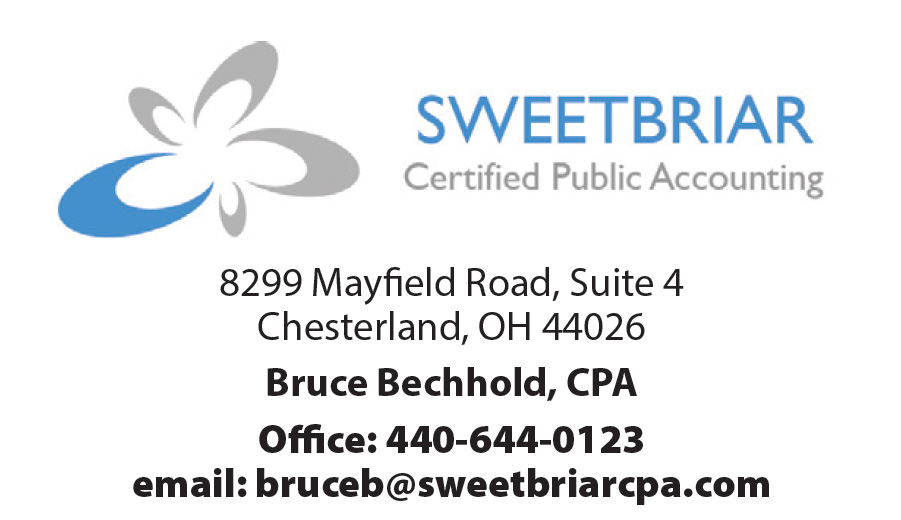 Bruce Bechhold, CPA, is committed to helping business owners with their tax, accounting, and business needs. His goal is to help clients grow their company, understand their financial statements, and reduce their tax exposure. Contact Bruce at 440-644-0123 or bruceb@sweetbriarcpa.com.
Bruce Bechhold, CPA, is committed to helping business owners with their tax, accounting, and business needs. His goal is to help clients grow their company, understand their financial statements, and reduce their tax exposure. Contact Bruce at 440-644-0123 or bruceb@sweetbriarcpa.com.
By Bruce Bechhold, CPA, SweetBriar Certified Public Accounting
I am often asked this question, so I thought it would be helpful to provide a general schedule for record retention for your business.
Consistent record retention supports a paper trail for organization activities and serves as documentation for a financial or IRS audit. The IRS offers record retention guidelines in Code Section 6001 and Publication 583 – Starting a Business and Keeping Records.
Heed the special retention requirements at the state level. For example, the tax collecting agency may have special requirements of trade show contracts or the agency approving continuing education may require forms be kept for a specific period.
Your organization’s accountant and attorney should provide advice on adopting a record retention schedule. Have the board adopt it as a policy; then have the staff conduct an annual file-cleanup to dispose of unnecessary documents.
Business records retention is required by the Internal Revenue Code, Employee Retirement Income Security Act and Uniform Commercial Code. The following business record retention schedule considers those laws.
Accordingly, this schedule should be used as a guide, modified as necessary to meet your specific needs. Be sure to contact legal and accounting professionals for specifics applying to your organization and its activities.
PERMANENT RECORDS
Capital stock and bond records: ledger, transfer registers, stubs showing issues, record of interest coupons, options, etc.
Correspondence (legal and important matters only)
Deeds, mortgages, and bills of sales, as well as contracts and leases still in effect
Financial statements-end of year
General and private ledgers
Insurance records, current accident reports, claims policies
Journals
Minute books of directors and stockholders, including by-laws and charter
Property appraisals by outside appraisers
Property records-including costs and depreciation schedules
Tax returns and worksheets, Revenue Agents’ Reports and other documents relating to determination of income tax liability
Trademark registrations
SEVEN YEARS
Accounts payable (see Voucher Register)
Accounts receivable ledgers and trial balances
Cancelled checks (see exception under Permanent Records)
Cancelled stock and bond certificates and expired options
Contracts and leases (expired)
Expense analyses and expense distribution schedules
Inventories of products, materials and supplies
Inventories to customers
Invoices from vendors
Notes receivable ledgers and trial balances
Payroll records and summaries, including payments to pensioners
Employee personnel records after termination (if a retirement plan was in effect, regardless if employee was a plan participant); (if employee was a participant in a pension plan, consult your plan advisor)
Retirement Plan returns and reports (from filing date of such returns and reports)
Retirement Plan accounting records (to correspond with returns and reports)
Purchase orders (purchasing department copy)
Sales records
Scrap and salvage records-inventories, sales, etc.
Subsidiary ledgers to the general ledger and trial balances
THREE YEARS
Applications for Employment
Employee personnel records after termination (see exception under Six to Seven Years)
General Correspondence
Insurance policies which have expired
Internal audit reports, including working papers (in some situations, longer retention periods may be desirable)
Miscellaneous internal reports
Petty cash vouchers
Physical inventory tags
Savings bond registration records of employees
ONE YEAR
Bank reconciliations
Bank statements
Duplicate deposit slips
Purchase orders
Receiving sheets
Note: It is critical to seek the advice of legal and accounting professionals when adopting a record retention schedule and board policy on record retention.
























